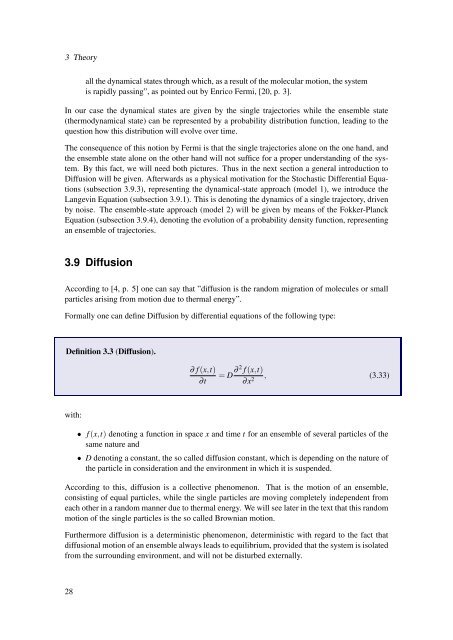Diffusion Processes with Hidden States from ... - FU Berlin, FB MI
Diffusion Processes with Hidden States from ... - FU Berlin, FB MI
Diffusion Processes with Hidden States from ... - FU Berlin, FB MI
Create successful ePaper yourself
Turn your PDF publications into a flip-book with our unique Google optimized e-Paper software.
3 Theoryall the dynamical states through which, as a result of the molecular motion, the systemis rapidly passing”, as pointed out by Enrico Fermi, [20, p. 3].In our case the dynamical states are given by the single trajectories while the ensemble state(thermodynamical state) can be represented by a probability distribution function, leading to thequestion how this distribution will evolve over time.The consequence of this notion by Fermi is that the single trajectories alone on the one hand, andthe ensemble state alone on the other hand will not suffice for a proper understanding of the system.By this fact, we will need both pictures. Thus in the next section a general introduction to<strong>Diffusion</strong> will be given. Afterwards as a physical motivation for the Stochastic Differential Equations(subsection 3.9.3), representing the dynamical-state approach (model 1), we introduce theLangevin Equation (subsection 3.9.1). This is denoting the dynamics of a single trajectory, drivenby noise. The ensemble-state approach (model 2) will be given by means of the Fokker-PlanckEquation (subsection 3.9.4), denoting the evolution of a probability density function, representingan ensemble of trajectories.3.9 <strong>Diffusion</strong>According to [4, p. 5] one can say that ”diffusion is the random migration of molecules or smallparticles arising <strong>from</strong> motion due to thermal energy”.Formally one can define <strong>Diffusion</strong> by differential equations of the following type:Definition 3.3 (<strong>Diffusion</strong>).∂ f (x,t)∂t= D ∂ 2 f (x,t)∂x 2 , (3.33)<strong>with</strong>:• f (x,t) denoting a function in space x and time t for an ensemble of several particles of thesame nature and• D denoting a constant, the so called diffusion constant, which is depending on the nature ofthe particle in consideration and the environment in which it is suspended.According to this, diffusion is a collective phenomenon. That is the motion of an ensemble,consisting of equal particles, while the single particles are moving completely independent <strong>from</strong>each other in a random manner due to thermal energy. We will see later in the text that this randommotion of the single particles is the so called Brownian motion.Furthermore diffusion is a deterministic phenomenon, deterministic <strong>with</strong> regard to the fact thatdiffusional motion of an ensemble always leads to equilibrium, provided that the system is isolated<strong>from</strong> the surrounding environment, and will not be disturbed externally.28









